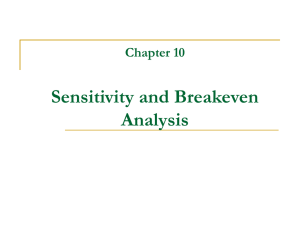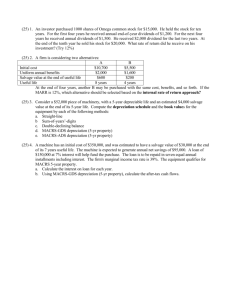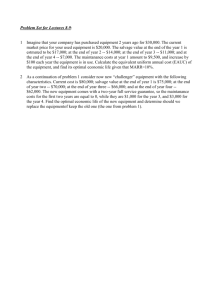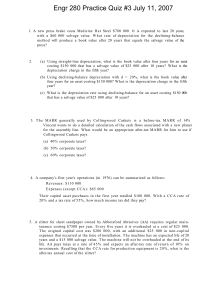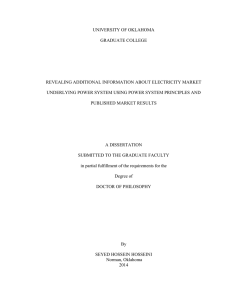Sensitivity and Breakeven Analysis
advertisement
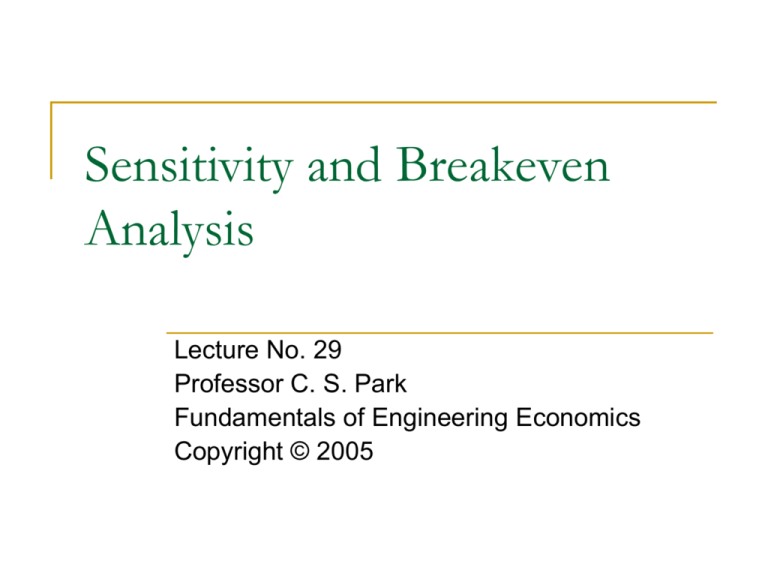
Sensitivity and Breakeven Analysis Lecture No. 29 Professor C. S. Park Fundamentals of Engineering Economics Copyright © 2005 Chapter 10 Handling Project Uncertainty Origin of Project Risk Methods of Describing Project Risk Probability Concepts for Investment Decisions Risk-Adjusted Discount Rate Approach In Engineering economics we predict cash flows How do you know for sure that what you are claiming for interest rate, costs, revenues remain true??? Well for some situations you can be close enough to consider your “single point” analysis to be worthwhile. For other you need to consider what is called RISK We use the term risk to describe an investment project where cash flows are not known in advanced with certainty. What to do: Instead of single point analysis, an array of outcomes and their probabilities or odds are to considered. Origins of Project Risk Risk: (in essence) the potential for loss Project Risk: variability in a project’s NPW Risk Analysis: The assignment of probabilities to the various outcomes of an investment project Methods of Describing Project Risk Sensitivity Analysis: a means of identifying the project variables which, when varied, have the greatest effect on project acceptability. Break-Even Analysis: a means of identifying the value of a particular project variable that causes the project to exactly break even. Scenario Analysis: a means of comparing a “base case” to one or more additional scenarios, such as best and worst case, to identify the extreme and most likely project outcomes. Sensitivity Analysis – Example 10.1 Transmission-Housing Project by Boston Metal Company New investment = $125,000 Number of units = 2,000 units Unit Price = $50 per unit Unit variable cost = $15 per unit Fixed cost = $10,000/Yr Project Life = 5 years Salvage value = $40,000 Income tax rate = 40% MARR = 15% Example 10.1 - After-tax Cash Flow for BMC’s TransmissionHousings Project – “Base Case” 0 1 2 3 4 5 Revenues: Unit Price Demand (units) Sales revenue 50 50 50 50 50 2,000 2,000 2,000 2,000 2,000 $100,000 $100,000 $100,000 $100,000 $100,000 Expenses: Unit variable cost $15 $15 $15 $15 $15 Variable cost 30,000 30,000 30,000 30,000 30,000 Fixed cost 10,000 10,000 10,000 10,000 10,000 Depreciation 17,863 30,613 21,863 15,613 5,575 Taxable Income $42,137 $29,387 $38,137 $44,387 $54,425 16,855 11,755 15,255 17,755 21,770 $25,282 $17,632 $22,882 $26,632 $32,655 Income taxes (40%) Net Income (Example 10.1, Continued) Cash Flow Statement 0 1 2 3 4 5 Operating activities Net income 25,282 17,632 22,882 26,632 32,655 Depreciation 17,863 30,613 21,863 15,613 5,575 Investment activities Investment (125,000) Salvage 40,000 Gains tax (2,611) Net cash flow ($125,500) $43,145 $48,245 $44,745 $42,245 $75,619 A B 1 Example 10.1 BMC's 2 13 Income Statement 14 0 15 Revenues: 16 Unit Price 17 Demand (units) 18 Sales Revenue 19 Expenses: 20 Unit Variable Cost 21 Variable Cost 22 Fixed Cost 23 Depreciation 24 C D E F G 4 5 Transmission-Housings Project 1 2 3 $ 50 $ 50 $ 50 $ 50 $ 50 2000 2000 2000 2000 2000 $ 100,000 $ 100,000 $ 100,000 $ 100,000 $ 100,000 $ 15 30,000 10,000 17,863 $ 15 30,000 10,000 30,613 $ 15 30,000 10,000 21,863 $ 15 30,000 10,000 15,613 $ 15 30,000 10,000 5,581 25 Taxable Income 26 27 Income Taxes (40%) $ 42,137 16,855 $ 29,387 11,755 $ 38,137 15,255 $ 44,387 17,755 $ 54,419 21,768 28 29 30 31 32 33 34 35 36 37 38 $ 25,282 $ 17,632 $ 22,882 $ 26,632 $ 32,651 25,282 17,863 17,632 30,613 22,882 21,863 26,632 15,613 32,651 5,581 Net Income Cash Flow Statement Operating Activities: Net Income Depreciation Investment Activities: Investment Salvage Gains Tax 39 Net Cash Flow 40 (125,000) $ (125,000) $ 43,145 40,000 (2,613) $ 48,245 $ 44,745 $ 42,245 $ 75,619 Example 10.1 - Sensitivity Analysis for Five Key Input Variables Deviation -15% -10% -5% 0% 5% 10% 15% 20% $57 $9,999 $20,055 $30,111 $40,169 $50,225 $60,281 $70,337 $80,393 Demand 12,010 19,049 26,088 33,130 40,169 47,208 54,247 61,286 68,325 Variable cost 52,236 49,219 46,202 43,186 40,169 37,152 34,135 31,118 28,101 Fixed cost 44,191 43,185 42,179 41,175 40,169 39,163 38,157 37,151 36,145 Salvage value 37,782 38,378 38,974 39,573 40,169 40,765 41,361 41,957 42,553 Unit price -20% Base Sensitivity graph – BMC’s transmission-housings project (Example 10.1) $100,000 90,000 Unit Price 80,000 70,000 Demand 60,000 50,000 Salvage value 40,000 Fixed cost Variable cost Base 30,000 20,000 10,000 0 -10,000 -20% -15% -10% -5% 0% 5% 10% 15% 20% Example 10.2 - Sensitivity Analysis for Mutually Exclusive Alternatives Electrical Diesel Power LPG Gasoline Fuel 7 year 7 years 7 years 7 years Initial cost $30,000 $21,000 $20,000 $25,000 Salvage value $3,000 $2,000 $2,000 $2,200 260 260 260 260 32 kWh 12 gal 11 gal 7 gal Fuel cost/unit $0.05/kWh $1.00/gal $1.20/gal $1.10/gal Fuel cost/shift $1.60 $12 $13.20 $7.7 $500 $1,000 $1,200 $1,500 $5 $6 $7 $9 Life expectancy Maximum shifts per year Fuel consumption/shift Annual maintenance cost: Fixed cost Variable cost/shift Capital (Ownership) Cost Electrical power: CR(10%) = ($30,000 - $3,000)(A/P, 10%, 7) + (0.10)$3,000 = $5,845 LPG: CR(10%) = ($21,000- $2,000)(A/P, 10%, 7) + (0.10)$2,000 = $4,103 Gasoline: CR(10%) = ($20,000-$2,000)(A/P, 10%, 7) + (0.10) $2,000 = $3,897 Diesel fuel: CR(10%) = ($25,000 -$2,200)(A/P, 10%, 7) +(0.10) $2,200 = $4,903 Annual O&M Cost Electrical power: $500 + (1.60 + 5)M = $500 + 6.6M LPG: $1,000 + (12 + 6)M = $1,000 + 18M Gasoline: $800 + (13.2 + 7)M = $800 + 20.20M Diesel fuel: $1,500 + (7.7 + 9)M = $1,500 + 16.7M Annual Equivalent Cost Electrical power: AE(10%) = 6,345 LPG: AE(10%) = 5,103 Gasoline: AE(10%) = 4,697 Diesel fuel: AE(10%) = 6,403 + 6.6M + 18M + 20.20M + 16.7M 12000 8000 Electrical LPG Gasoline 6000 Disel Fuel 4000 2000 Number of Shifts (M) 260 240 220 200 180 160 140 120 100 80 60 40 20 0 0 Annual Equivalent Cost ($) 10000 Break-Even Analysis Excel using a Goal Seek function Analytical Approach Excel Using a Goal Seek Function ? Goal Seek Set cell: X NPW $F$5 0 To value: By changing cell: Ok Breakeven Value $B$6 Cancel Demand A Goal Seek Function Parameters 1 2 3 4 5 6 7 8 9 10 11 12 13 14 15 16 17 18 19 20 21 22 23 24 25 B C D E F G Example 10.3 Break-Even Analysis Input Data (Base): Unit Price ($) Demand Var. cost ($/unit) Fixed cost ($) Salvage ($) Tax rate (%) MARR (%) Output Analysis: $ $ $ $ 50 1429.39 15 10,000 40,000 40% 15% Output (NPW) 0 Income Statement Revenues: Unit Price Demand (units) Sales Revenue Expenses: Unit Variable Cost Variable Cost Fixed Cost Depreciation 1 2 $0 3 4 5 $ 50 $ 50 $ 50 $ 50 $ 50 1429.39 1429.39 1429.39 1429.39 1429.39 $ 71,470 $ 71,470 $ 71,470 $ 71,470 $ 71,470 $ 15 21,441 10,000 17,863 $ 15 21,441 10,000 30,613 $ 15 21,441 10,000 21,863 $ 15 21,441 10,000 15,613 $ 15 21,441 10,000 5,581 26 Taxable Income 27 28 Income Taxes (40%) $ 22,166 8,866 $ 9,416 3,766 $ 18,166 7,266 $ 24,416 9,766 $ 34,448 13,779 29 30 31 32 33 34 35 36 37 38 39 $ 13,299 $ 5,649 $ 10,899 $ 14,649 $ 20,669 10,899 21,863 14,649 15,613 Net Income Cash Flow Statement Operating Activities: Net Income Depreciation Investment Activities: Investment Salvage Gains Tax 40 Net Cash Flow 41 13,299 17,863 5,649 30,613 20,669 5,581 (125,000) 40,000 (2,613) $ (125,000) $ 31,162 $ 36,262 $ 32,762 $ 30,262 $ 63,636 Analytical Approach Unknown Sales Units (X) 0 1 2 3 4 5 Cash Inflows: Net salvage 37,389 X(1-0.4)($50) 30X 30X 30X 30X 30X 7,145 12,245 8,745 6,245 2,230 -X(1-0.4)($15) -9X -9X -9X -9X -9X -(0.6)($10,000) -6,000 -6,000 -6,000 -6,000 -6,000 21X + 1,145 21X + 6,245 21X + 2,745 21X + 245 21X + 33,617 0.4 (dep) Cash outflows: Investment Net Cash Flow -125,000 -125,000 PW of cash inflows PW(15%)Inflow= (PW of after-tax net revenue) + (PW of net salvage value) + (PW of tax savings from depreciation = 30X(P/A, 15%, 5) + $37,389(P/F, 15%, 5) + $7,145(P/F, 15%,1) + $12,245(P/F, 15%, 2) + $8,745(P/F, 15%, 3) + $6,245(P/F, 15%, 4) + $2,230(P/F, 15%,5) = 30X(P/A, 15%, 5) + $44,490 = 100.5650X + $44,490 PW of cash outflows: PW(15%)Outflow = (PW of capital expenditure_ + (PW) of after-tax expenses = $125,000 + (9X+$6,000)(P/A, 15%, 5) = 30.1694X + $145,113 The NPW: PW (15%) = 100.5650X + $44,490 - (30.1694X + $145,113) =70.3956X - $100,623. Breakeven volume: PW (15%) Xb = 70.3956X - $100,623 = 0 =1,430 units. PW of inflow PW of Outflow NPW X 100.5650X - $44,490 30.1694X + $145,113 70.3956X -$100,623 0 $44,490 $145,113 100,623 500 94,773 160,198 65,425 1000 145,055 175,282 30,227 1429 188,197 188,225 28 1430 188,298 188,255 43 1500 195,338 190,367 4,970 2000 245,620 205,452 40,168 2500 295,903 220,537 75,366 Demand Break-Even Analysis Chart $350,000 300,000 Break-even Volume 200,000 Profit Outflow 150,000 Xb = 1430 PW (15%) 250,000 Loss 100,000 50,000 0 -50,000 -100,000 0 300 600 900 1200 1500 Annual Sales Units (X) 1800 2100 2400 Scenario Analysis Variable Considered WorstCase Scenario Most-LikelyCase Scenario Best-Case Scenario Unit demand 1,600 2,000 2,400 Unit price ($) 48 50 53 Variable cost ($) 17 15 12 Fixed Cost ($) 11,000 10,000 8,000 Salvage value ($) 30,000 40,000 50,000 PW (15%) -$5,856 $40,169 $104,295
